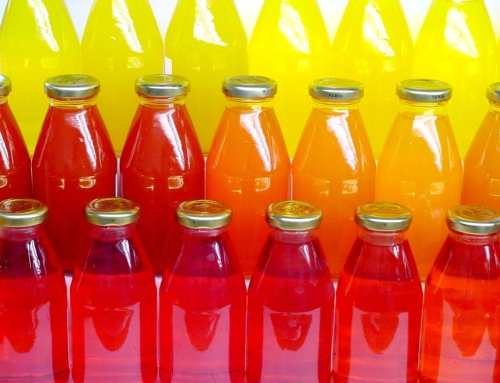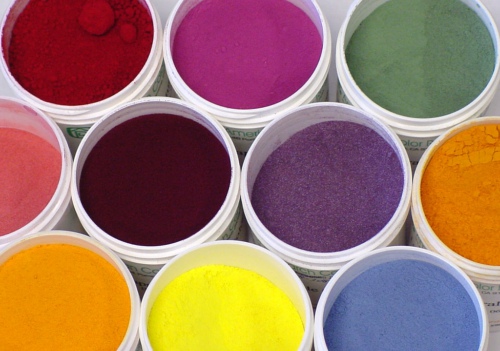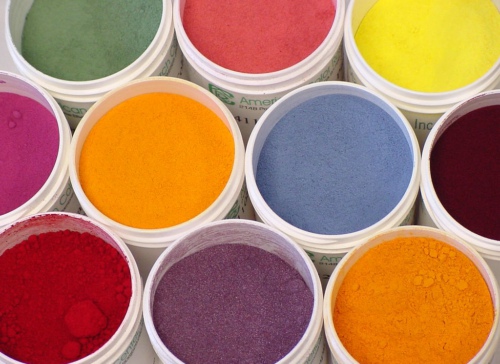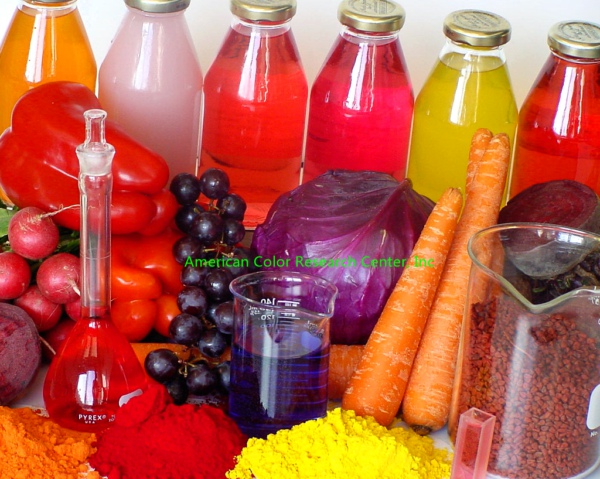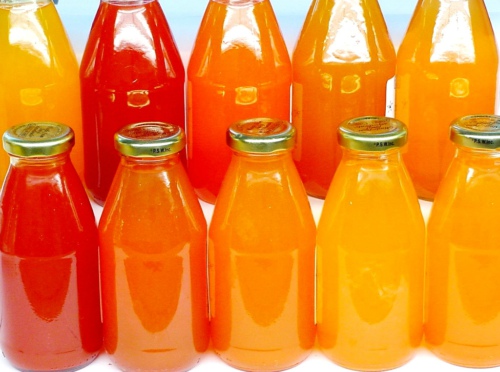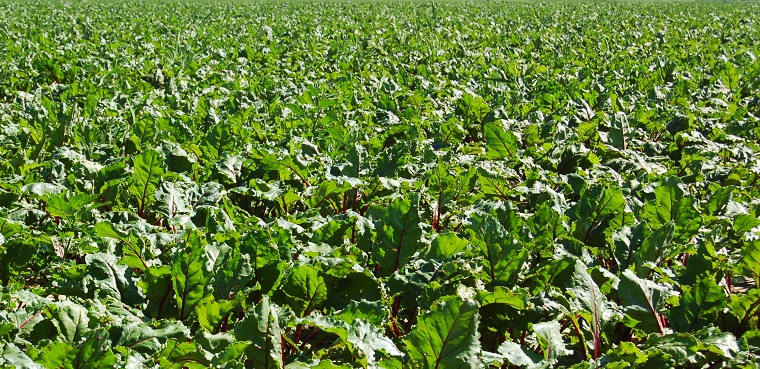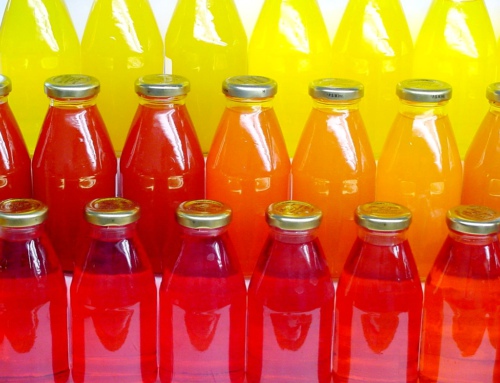I. Vegetable Derived Natural Blue Color. (21 CFR 73:250, 73:260. 73:169, 73:170 and E163)
Many vegetables and fruits display beautiful colors, due to naturally contained colorants, mainly anthocyanins, chlorophylls,
carotennoids and betanin. Anthocyanins give red (radish, red cabbage and strawberry) purple (purple sweet potato, purple
potato, purple corn, and red cabbage), black (black bean, black rice, black carrot, black currant) and blue (blueberry, concord
grape). Chlorophylls are usually found in green leaves and stems. Carotenoids exist in carrot, pupkin, yellow sweet potato,
red and bell peppers. While betanin is responsible for red color in beet and amaranth. Many of these naturally existing colors
in vegetables and fruits can be used as food colorants.
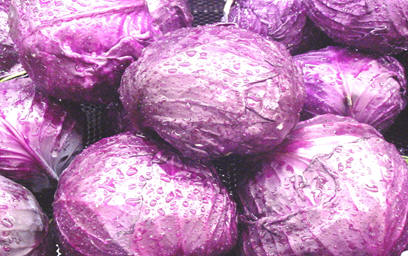
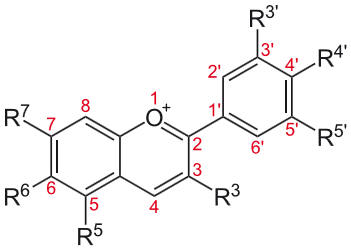
Anthocyanins is a water soluble substance and have a common molecular structure:
The R groups may be -H. -OH or -OCH3, and differ from sources to sources. One of the important characteristics of
anthocyanins is pH sensitivty. As pH changes from acidic, neutral to alkaline, the following consequences may occur:
1. Color change from red, purple to blue. green or colorless.
2. Color stability reduces
3. Color intensity changes.
By carefully select the anthocyanin sources and carefully controlling pH, we produce blue colors from vegetable:
1024ualg, Natural Blue Color
Form: Liquid.
Solubility: Water
Stability: Light: excellent
Heat: fair
pH: sensitive: pH <4, red; pH4-6.5, purple; pH 6.5-7.5,blue.
Applications:
Used as a natural food colorant to color food items like frosting, icing, ice cream,
popsicles, noodle/pasta
2597uapg Natural Blue Color.

Form: Powder.
Solubility: water
Stability: Light: excellent
Heat: fair
pH: sensitive: pH <4, red. pH4-6.5, purple. pH 6.5-7.5: blue. Applications: Used as a natural food colorant to color food items like drink mix, chewable tablet, chocolate coating, frosting, icing, ice cream, popsicles, noodle/pasta
II. Natural Blue Color from Spirulina
Spirulina, a green algae, is used as a nutritional supplement for long time. It is rich in protein, vitamins, minerals and carotenoids. It is also used as an antioxidants to protect cells from damage and aging. Spirulina blue color is extracted from spirulina algae.
2665uapg Spirulina Blue Color (Spirulina extract, 21 CFR73:530)
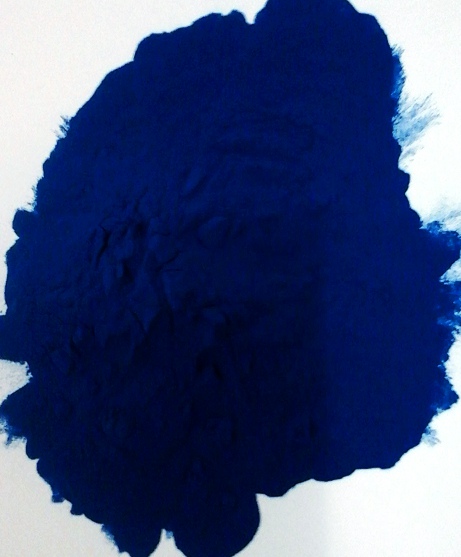 Form: Powder.
Form: Powder.
Solubility: water
Stability:
Light: excellent
Heat: poor
pH: sensitive: used in pH>5.
Applications:
Used as a natural food colorant to color food items like candy, chewing gum,
frostings, ice cream and frozen desserts, dessert coatings and toppings,
beverage mixes and powders, yogurts, custards, puddings, cottage cheese,
gelatin, breadcrumbs and ready-to-eat cereals (excluding extruded cereals).”
Natural Brown Color
Caramel Colors (21 CFR 73:85, E150(a, b, c and d)
 Caramel colors are made by heating carbohydrates under controlled
Caramel colors are made by heating carbohydrates under controlled
conditions. Depending on the presence of different reactants in processing,
caramels are divided into four classes:
Class I: No sulfite or ammonium can be used in processing.
Class II: Sulfite but not ammonium salts can be used.
Class III. Ammonium but not sulfite can be used
Class IV: Both sulfite and ammonium salts can be used.
Form: Powder and liquid both are available
Solubility: water
Stability: Light: Excellent
Heat: Excellent
pH: Variable from Class I to Class IV
Used as a natural food colorant to color all kinds of foods including alcoholic and non-alcoholic
beverages, drink mix, bakery, confectionery, snack, chewable tablet, frosting, icing, ice cream,
popsicles, noodle/pasta meats and sea foods, soups and pet foods
Natural Green Color
Compounded Natural Green Color
Natural green color can be achieved by compounding a natural blue color and a natural yellow color. Depending
on applications, the blue color may be selected from anthocyanin or spirulina blue colors, while the yellow color
can be turmeric, beta carotene, saffron and other natural colors.
1025-galg. Natural Green Color.
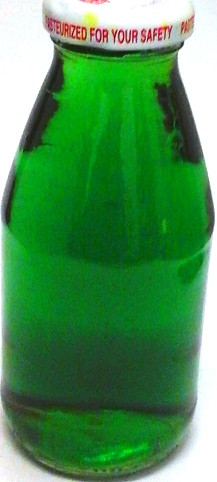 Forms: Liquid
Forms: Liquid
Solubility: Water
Stability: Light: Good
Heat: Fair
pH: Sensitive. Works in pH 6.5-7.5
Applications:
Used as a natural food colorant to color food items like frosting, icing, ice
cream, popsicles, noodle/pasta
2603gapg Natural Green Color
 Form: Powder
Form: Powder
Solubility: water
Stability: Light: Excellent
Heat: Excellent when dry
pH: Sensitive when wet.
Applications:
Used as a natural food colorant to color food items like tablets, chocolate coating, drink mix,
bakery, confectionery, snack, chewable tablet, rosting, icing, ice cream, popsicles, noodle/pasta
2434gapg Disodium copper Chlorophyllin (21 CFR 73:1125, E141)
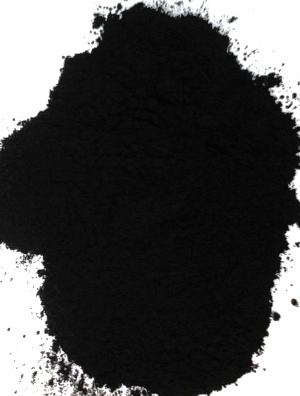 Chlorophylls exist in green leaves and stems of plants. The color additive
Chlorophylls exist in green leaves and stems of plants. The color additive
potassium sodium copper chlorophyllin is a green to black powder obtained
from chlorophyll by replacing the methyl and phytyl ester groups with alkali
and replacing the magnesium with copper. The source of the chlorophyll is
dehydrated alfalfa.
Form:
Powder and liquid
Solubility: water
Stability: Light: Excellent
Heat: Excellent
pH: fair
Applications:
Used as a natural food colorant to color food items like chewing gum, ice cream, sauce,
soups and green vegetables and fruits preserved in liquids.
It can be used in citrus flavored drink mix only in USA
Natural Orange Color
I. Annatto Colors (21 CFR 73:30, E160b)
The Annatto color is extract of the outer layer of the seeds of the Bixa Orellana tree. It is native to
northern South America but now it is found in South East Asia and Africa, The fat soluble color in
the crude extract is called bixin, which can then be saponified into water soluble norbixin. Both
bixin and norbixin belong to Carotenoids family but they are not vitamin A precursors.
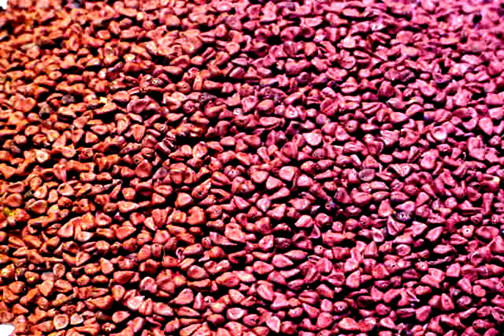

1955-oalg, Natural Orange Color, Organic compliant. This acid proof annatto emulsion does not contain polysorbates nor propylene glycol.
Form: Liquid.
Solubility: Water
Stability: Light: good
Heat: good
pH: good
Applications:
Used as a natural food colorant to color food items like dairy (cheese,
yogurt, butter, margarine), rice, custard powder, seasonings, processed
potato, drink, baked foods, cereals, extruded breakfast, frosting, icing,
confectionery, chocolate coating, chewing gums, gelatin, snacks, fruit
juice and paste, ice cream, popsicles, noodle/pasta, smoked fish/meats,
and many other foods.
1972oalb Natural Orange Color, Acid Stable, Stabilized against light. This annatto solution does not contain polysorbate 80.
Form: Liquid.
Solubility: Water
Stability: Light: good
Heat: good
pH: good
Applications:
Used as a natural food colorant to color food items like beverage, dairy
(cheese, yogurt, butter, margarine), rice, custard powder, seasonings,
processed potato, drink, baked foods, cereals, extruded breakfast,
frosting, icing, confectionery, chocolate coating, chewing gums, gelatin,
snacks, fruit juice and paste, ice cream, popsicles, noodle/pasta, smoked
fish/meats, and many other foods.
1504oalg Natural Orange Color
 Form: Liquid.
Form: Liquid.
Solubility: Water
Stability: Light: good
Heat: good
pH: good
Applications:
Used as a natural food colorant to color food items like dairy (cheese,
yogurt, butter, margarine), rice, custard powder, seasonings, processed
potato, drink, baked foods, cereals, extruded breakfast, frosting, icing,
confectionery, chocolate coating, chewing gums, gelatin, snacks, fruit
juice and paste, ice cream, popsicles, noodle/pasta, smoked fish/meats,
and many other foods.
1011oalg Natural Orange Color
Form: Liquid.
Solubility: Water
Stability: Light: good
Heat: good
pH: Poor
Applications:
Used as a natural food colorant to color food items like dairy (cheese, yogurt, butter,
margarine), rice, custard powder, seasonings, processed potato, baked foods, cereals,
extruded breakfast, frosting, icing, confectionery, chocolate coating, chewing gums, gelatin,
snacks, rice, cream, popsicles, noodle/pasta, smoked fish/meats, and many other foods.
2136oapg Natural Orange Color, Organic compliant
 Form: Powder.
Form: Powder.
Solubility: Water
Stability: Light: good
Heat: good
pH: poor
Applications:
Used as a natural food colorant to color food items like drink mix, bakery
mix, dairy (cheese, yogurt, butter, margarine), rice, custard powder,
seasonings, processed potato, baked foods, cereals, extruded breakfast,
frosting, icing, confectionery, chocolate coating, chewing gums, gelatin,
snacks, fruit juice and paste, ice cream, popsicles, noodle/pasta, smoked
fish/meats, and many other foods.
Back to top
II. Beta Carotene Yellow/Orange Colors (21 CFR 73:95, E160a)
Beta Carotene is a very important member of carotenoids due to its function as a precursor of vitamin A.
It is abundant in nature such as carrots, pumpkin, and sweet potatoes. However, these vegetables are not
widely used to extract beta carotene due to economical reason. The commercially available beta-carotene
from nature is extracted from algae, Dunaliella Salina, for example, or from fermentation nowadays.
Being a non-polar compound, beta carotene is a lipophilic, and therefore is a water insoluble substance.

This property limits its application for fatty/oily foods only. However, advanced emulsification
technologies have successfully converted it to water dispersible versions, enable it can be widely used in
water based foods including beverages. However, some beta carotene emulsions available in market form
rings on beverage bottle necks after storage, due to separation of oil-soluble beta carotene from beverage
water. This may be caused by insufficient emulsification in processing or poor stability of the emulsions.
We have successfully created a beta carotene emulsion which can be used in beverages without
ringing/separation. This emulsion also has improved light and heat stability, giving extended shelf life of the
beverages.
1224-oalb, Natural Orange/Yellow Color. (natural beta carotene emulsion, ringing-free).
 Ringing free. Gives bright yellow to orange colors in beverage, depending on use
Ringing free. Gives bright yellow to orange colors in beverage, depending on use
levels. A good substitute for Yellow No. 5.
Form: Liquid
Solubility: Water
Stability: Light: good
Heat: excellent
pH: excellent
Applications:
Used as a natural food colorant to color food items like different beverages, including
alcoholic and non-alcoholic, carbonated and non-carbonated, dairy (cheese, yogurt,
butter, margarine), rice, baked foods, cereals, extruded breakfast, frosting, icing,
confectionery, chocolate coating, chewing gums, gelatin, snacks, fruit juice and paste,
ice cream, popsicles, noodle/pasta, smoked fish/meats, and many other foods.
1229oalb, Beta Carotene Color (beta carotene emulsion, ringing-free).
 Ringing Free. Gives bright yellow to orange colors in beverage, depending on
Ringing Free. Gives bright yellow to orange colors in beverage, depending on
use levels. A good substitute for Yellow No. 5.
Form: Liquid
Solubility: Water
Stability: Light: good
Heat: excellent
pH: excellent
Applications:
Used as a natural food colorant to color food items like different
beverages, including alcoholic and non-alcoholic, carbonated and
non-carbonated, dairy (cheese, yogurt, butter, margarine), rice,
baked foods, cereals, extruded breakfast, frosting, icing,
confectionery, chocolate coating, chewing gums, gelatin, snacks,
fruit juice and paste, ice cream, popsicles, noodle/pasta, smoked
fish/meats, and many other foods.
2415oapb Natural Beta Carotene Color Powder (1% beta carotene)
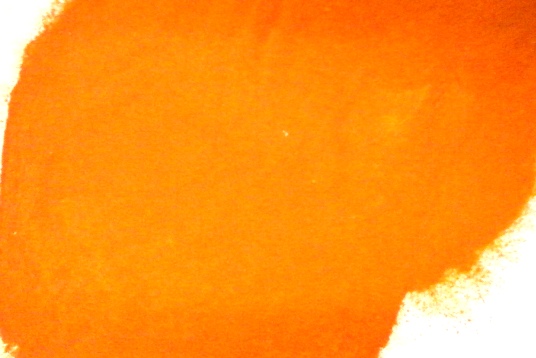 Form: Powder
Form: Powder
Solubility: Water
Stability: Light: good
Heat: excellent
pH: excellent
Applications:
Used as a natural food colorant to color food items
like drink mix, different ready-to drink beverages,
including alcoholic and non-alcoholic, carbonated
and non-carbonated, bakery mixes, dairy (cheese,
yogurt, butter, margarine), rice, baked foods, cereals,
extruded breakfast, frosting, icing, confectionery,
chocolate coating, chewing gums, gelatin, snacks,
fruit juice and paste, ice cream, popsicles, noodle/
pasta, smoked fish/meats, and many other foods.
1858oapb Beta Carotene Color (1% beta carotene)
Form: Powder
Solubility: Water
Stability: Light: good
Heat: excellent
pH: excellent
Applications:
Used as a natural food colorant to color food items like drink mix, Ready-to-drink
beverages, including alcoholic and non-alcoholic, carbonated and non-carbonated, bakery
mixes, dairy (cheese, yogurt, butter, margarine), rice, baked foods, cereals, extruded
breakfast, frosting, icing, confectionery, chocolate coating, chewing gums, gelatin, snacks,
fruit juice and paste, ice cream, popsicles, noodle/pasta, smoked fish/meats, and many other
foods.
2400oapb Beta Carotene Color (10% beta carotene)
Form: Powder
Solubility: Water
Stability: Light: good
Heat: excellent
pH: excellent
Applications:
Used as a natural food colorant to color food items like different beverages, including
alcoholic and non-alcoholic, carbonated and non-carbonated, drink mixes, bakery mixes,
dairy (cheese, yogurt, butter, margarine), rice, baked foods, cereals, extruded breakfast,
frosting, icing, confectionery, chocolate coating, chewing gums, gelatin, snacks, fruit juice
and paste, ice cream, popsicles, noodle/pasta, smoked fish/meats, and many other foods.
III. Canthaxanthin Red Color (CFR 73:75, 73:1075 and E161g)
Canthaxanthin is a member of caratenoids. It is widely distributed in nature such as mushrooms, algae,
sea weed and some fishes. That flamingos get red, orange and yellow colors on their feather is a result of
eating canthaxanthin-rich foods, including some species of fish. As a member of carotenoids,
canthaxanthin is a strong antioxidant. It was reported the strongest oil soluble antioxidant found in nature.
It plays the role of free radical-scavenger and prevent cell walls from damage by free radicals.
Canthaxanthin is approved for use as a food and feed coloring agent in different countries, including the
United States and the EU. Canthaxanthin can be used as a red color at a higher concentration and an
orange color at a lower concentration.
2460oapg Canthaxanthin Orange color
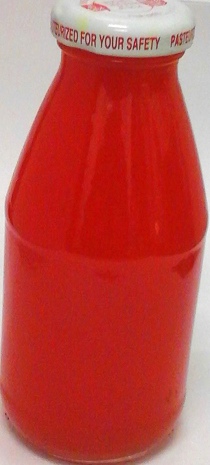 Form: Granular
Form: Granular
Solubility: Water
Stability: Light: good
Heat: excellent
pH: excellent
Applications:
Used as a natural food colorant to color food items like processed meats
and sea foods, beverages, including alcoholic and non-alcoholic,
carbonated and non-carbonated, bakery mixes, dairy (cheese, yogurt,
butter, margarine), rice, baked foods, cereals, extruded breakfast,
frosting, icing, confectionery, chocolate coating, chewing gums, gelatin,
snacks, fruit juice and paste, ice cream, popsicles, noodle/pasta, smoked
fish/meats, pet foods and animal feeds.
IV. Lycopene (CFR 73:585, E160d)
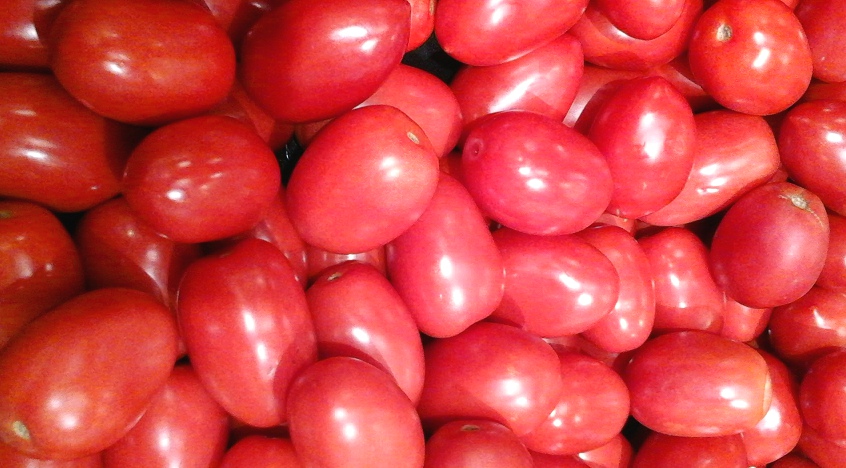
Lycopene is a orange red pigment found in
many fruits, vegetables and algae, including
tomatoes, watermelons, gacs, papayas and
carrots, Lycopene is a member of carotenoids
and have excellent antioxidant activity due to its
eleven conjugated double bonds in its molecular
structure. Lycopene is an oil soluble substance
but it is emulsified to water soluble form for many food uses. It can be used as an orange color at lower
use level, as well as a red color at higher concentration.
2472rapb Lycopene Color 5% Powder
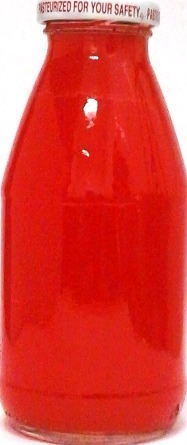 Form: Granular
Form: Granular
Solubility: Water
Stability: Light: good
Heat: excellent
pH: excellent
Applications:
Used as a natural food colorant to color food items like processed meat
and sea foods, beverages, including alcoholic and non-alcoholic,
carbonated and non-carbonated, drink mixes, bakery mixes, dairy, rice,
baked foods, cereals, extruded breakfast, frosting, icing, confectionery,
chocolate coating, chewing gums, gelatin, snacks, fruit juice and paste,
ice cream, popsicles, noodle/pasta, smoked fish/meats, pet foods and
animal feeds.
2473rapb Lycopene Color 10% powder
Form: Granular
Solubility: Water
Stability: Light: good
Heat: excellent
pH: excellent
Applications:
Used as a natural food colorant to color food items like processed meats and sea foods,
beverages, including alcoholic and non-alcoholic, carbonated and non-carbonated, drink
mixes, bakery mixes, dairy, rice, baked foods, cereals, extruded breakfast, frosting, icing,
confectionery, chocolate coating, chewing gums, gelatin, snacks, fruit juice and paste, ice
cream, popsicles, noodle/pasta, smoked fish/meats, pet foods and animal feeds.
1491rflg Lycopene Color 20% oil suspension
Form: Liquid
Solubility: Oil
Stability: Light: good
Heat: excellent
pH: excellent
Applications:
Used as a natural food colorant to color food items like dairy (cheese, butter, margarine),
baked foods, cereals, extruded breakfast, frosting, icing,
chocolate coating, ice cream, noodle/pasta, smoked fish/meats, pet foods and animal feeds.
1094oflg Lycopene Color oil solution
Form: Liquid
Solubility: oil
Stability: Light: good
Heat: excellent
pH: excellent
Applications:
Used as a natural food colorant to color food items like dairy (cheese, butter, margarine),
baked foods, cereals, extruded breakfast, frosting, icing, chocolate coating, ice cream,
noodle/pasta, smoked fish/meats, pet foods and animal feeds.
V. Paprika Oleoresin (CFR73:345, E160c)
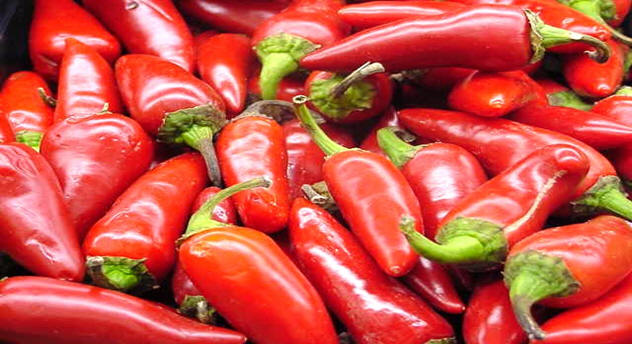 Paprika oleoresin or paprika extract is an oil soluble extract from the fruits of red pepper. It is also
Paprika oleoresin or paprika extract is an oil soluble extract from the fruits of red pepper. It is also
emulsified to water soluble for food coloring applications. It’s main coloring components are
capsaicin and capsorubin, both are members of carotenoids. Paprika Oleoresin or extract gives
orange to red colors in food applications, depending on the use levels.
2517oflg Natural Orange Color (paprika oleoresin)
Form: Liquid
Solubility: oil
Stability: Light: good
Heat: excellent
pH: excellent
Applications:
Used as a natural food colorant to color food items like dairy (cheese, butter, margarine),
baked foods, cereals, extruded breakfast, frosting, icing, chocolate coating, ice cream,
noodle/pasta, smoked fish/meats, pet foods and animal feeds.
1298oalb Natural Orange Color (paprika Color Water Soluble)
Form: Liquid
Solubility: Water
Stability: Light: good
Heat: excellent
pH: excellent
Applications:
Used as a natural food colorant to color food items like different
beverages, including alcoholic and non-alcoholic, carbonated and
non-carbonated, drink mixes, bakery mixes, dairy, rice, baked
foods, cereals, extruded breakfast, frosting, icing, confectionery,
chocolate coating, chewing gums, gelatin, snacks, fruit juice and
paste, ice cream, popsicles, noodle/pasta, smoked fish/meats,
pet foods and animal feeds.
Natural Pink Color
1737ralb Natural Red Color
Solubility: water
Stability: Light: excellent
Heat: fair
pH: sensitive
Applications:
Used as a natural food colorant to color food items like beverages,
dairy, candy, chewing gum, salad dressing, fruit juice and
concentrates, frostings, ice cream, and frozen desserts, dessert,
coatings and toppings, yogurts, custards, puddings, gelatin and other
foods.
1420rapb Natural Red Color
Form: Powder.
Solubility: water
Stability: Light: excellent
Heat: fair
pH: sensitive.
Applications:
Used as a natural food colorant to color food items like beverages, drink mix, dairy, candy,
chewing gum, salad dressing, fruit juice and concentrates, frostings, ice cream, and frozen
desserts, dessert, coatings and toppings, beverage mixes and powders, yogurts, custards,
puddings, gelatin and other foods.
1411rapt Natural Pink-Red Color
 Form: Powder.
Form: Powder.
Solubility: water
Stability: Light: excellent
Heat: good when dry
pH: good when dry, sensitive when wet.
Applications:
Used as a natural food colorant to color food items like chewable tablets, chocolate coating,
drink mix, dairy, candy, chewing gum, salad dressing, fruit juice and concentrates, frostings,
ice cream, and frozen desserts, dessert, coatings and toppings, beverage mixes and
powders, yogurts, custards, puddings, gelatin and other foods.
Natural Purple Color
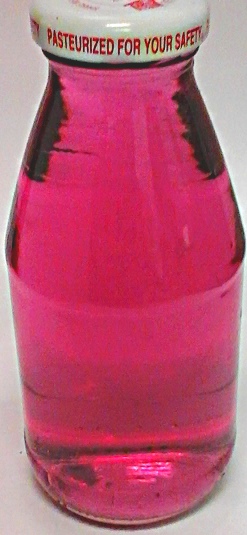 Grape juice concentrate and grape skin extract (21 CFR 73:169, 170, E163)
Grape juice concentrate and grape skin extract (21 CFR 73:169, 170, E163)
2563papb Natural Purple Color
Form: Powder.
Solubility: Water
Stability: Light: excellent
Heat: fair
pH: sensitive.
Applications:
Used as a natural food colorant to color food items like beverages,
drink mix, dairy, candy, chewing gum, salad dressing, fruit juice
and concentrates, frostings, ice cream, and frozen desserts,
dessert, coatings and toppings, beverage mixes and powders,
yogurts, custards, puddings, gelatin and other foods.
2621palb Natural Purple Color
Form: liquid.
Solubility: water
Stability: Light: excellent
Heat: fair
pH: sensitive
Applications:
Used as a natural food colorant to color food items like beverages, dairy, candy,
chewing gum, salad dressing, fruit juice and concentrates, frostings, ice cream, and
frozen desserts, dessert, coatings and toppings, yogurts, custards, puddings,
gelatin and other foods.
2601papg Natural purple Color Powder
Form: Powder.
Solubility: water
Stability: Light: excellent
Heat: fair
pH: sensitive
Applications:
Used as a natural food colorant to color food items like tablet, chocolate coating,
drink mix, dairy, candy, chewing gum, frostings, ice cream, and frozen desserts,
dessert, toppings, yogurts, custards, puddings, gelatin and other foods.
Natural Red Color
I. Anthocyanin Red Colors (21 CFR 73:250, 73:260. 73:169, 73:170 and E163)


Many vegetables and fruits have beautiful colors, due to naturally contained colorants, mainly
anthocyanins, chlorophylls, carotennoids and betanin. Anthocyanins give red (radish, red cabbage and
strawberry) purple (purple sweet potato, purple potato, purple corn, and red cabbage), black (black bean,
black rice, black carrot, black currant) and blue (blueberry, concord grape). Chlorophylls are usually found
in green leaves and stems. Carotenoids exist in carrot, pumpkin, yellow sweet potato, red and bell peppers.
While betanin is abundant in beet, and amaranth. Many of these naturally existing colors in vegetables and
fruits and be used as food colorants. Anthocyanins are a water soluble substances and have a common
molecular structure:

The R groups may be -H. -OH or -OCH3, and differ from sources to sources.
Anthocyanins are pH sensitive. The are three consequences as pH changes from acidc, neutral to alkaline:
1. color change from red, purple to blue. green or colorless.
2. color stability reduces
3. color intensity reduces.
Anthocyanin colors are accepted worldwide for food coloring.
1737-ralb, Natural Red Color (Red Radish Color)
 Form: liquid.
Form: liquid.
Solubility: water
Stability: Light: excellent
Heat: fair
pH: sensitive
Applications:
Used as a natural food colorant to color food items like beverages, dairy,
candy, chewing gum, salad dressing, fruit juice and concentrates,
frostings, ice cream, and frozen desserts, dessert, coatings and toppings,
yogurts, custards, puddings, gelatin and other foods.
1415-ralb, Natural Red Color (Red Cabbage Color)
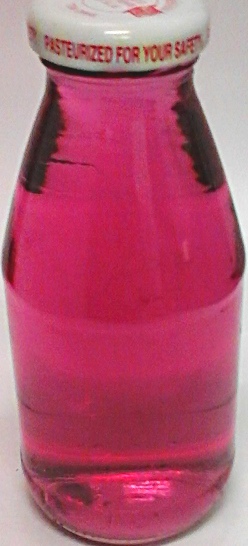 Form: liquid.
Form: liquid.
Solubility: water
Stability: Light: excellent
Heat: fair
pH: sensitive
Applications:
Used as a natu
ral food colorant to color food items like beverages, dairy,
candy, chewing gum, salad dressing, fruit juice and concentrates,
frostings, ice cream, and frozen desserts, dessert, coatings and toppings,
yogurts, custards, puddings, gelatin and other foods.
1236ralb Natural Red Color (Purple Sweet Potato Color)

Form: Liquid.
Solubility: Water
Stability: Light: excellent
Heat: fair
pH: sensitive
Applications:
Used as a natural food colorant to color food items like beverages, dairy,
candy, chewing gum, salad dressing, fruit juice and concentrates, fruit
jams, tomato sauce, tomato paste, frostings, ice cream, and frozen
desserts, dessert, coatings and toppings, yogurts, custards, puddings,
gelatin and other foods.
2613rapb Natural Red Color (Red Cabbage Color)
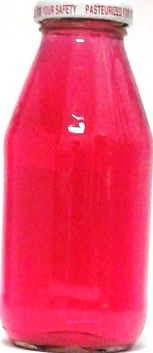 Form: Powder.
Form: Powder.
Solubility: Water
Stability: Light: excellent
Heat: fair
pH: sensitive
Applications:
Used as a natural food colorant to color food items like beverages,
Beverage mix, dairy, candy, chewing gum, salad dressing, fruit juice and
concentrates, fruit jams, tomato sauce, tomato paste, frostings, ice cream,
and frozen desserts, dessert, coatings and toppings, yogurts, custards,
puddings, gelatin and other foods.
1420rapb Natural Red Color (Red Radish Color)
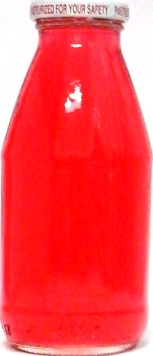 Form: Powder.
Form: Powder.
Solubility: Water
Stability: Light: excellent
Heat: fair
pH: sensitive
Applications:
Used as a natural food colorant to color food items like beverages,
Beverage mix, dairy, candy, chewing gum, salad dressing, fruit juice and
concentrates, fruit jams, tomato sauce, tomato paste, frostings, ice cream,
and frozen desserts, dessert, coatings and toppings, yogurts, custards,
puddings, gelatin and other foods.
2172rapb Natural Red Color Powder (Purple Carrot Color)
Form: Powder.
Solubility: Water
Stability: Light: excellent
Heat: fair
pH: sensitive
Applications:
Used as a natural food colorant to color food items like beverages, Beverage mix, dairy,
candy, chewing gum, salad dressing, fruit juice and concentrates, fruit jams, tomato sauce,
tomato paste, frostings, ice cream, and frozen desserts, dessert, coatings and toppings,
yogurts, custards, puddings, gelatin and other foods.
2425ralb Natural Red Color (Purple Carrot Color)
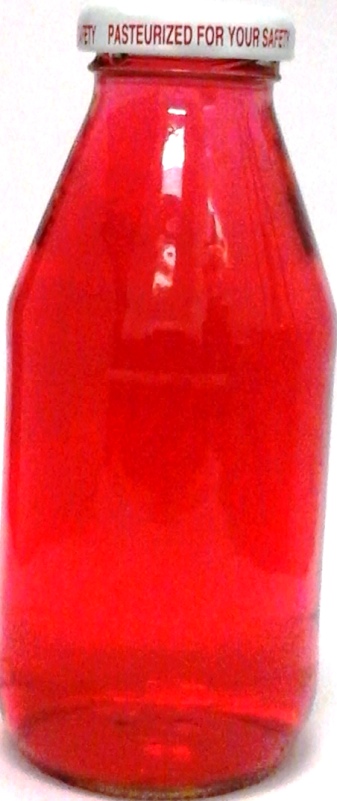 Form: Liquid.
Form: Liquid.
Solubility: Water
Stability: Light: excellent
Heat: fair
pH: sensitive
Applications:
Used as a natural food colorant to color food items like beverages, dairy,
candy, chewing gum, salad dressing, fruit juice and concentrates, fruit
jams, tomato sauce, tomato paste, frostings, ice cream, and frozen
desserts, dessert, coatings and toppings, yogurts, custards, puddings,
gelatin and other foods.
1846rapb Natural Red Color (Grape Color)
Form: Powder.
Solubility: Water
Stability: Light: excellent
Heat: fair
pH: sensitive
Applications:
Used as a natural food colorant to color food items like beverages, Beverage mix, dairy,
candy, chewing gum, salad dressing, fruit juice and concentrates, fruit jams, tomato sauce,
tomato paste, frostings, ice cream, and frozen desserts, dessert, coatings and toppings,
yogurts, custards, puddings, gelatin and other foods.
2620ralb Natural Red Color (Grape Color)
 Form: Liquid
Form: Liquid
Solubility: Water
Stability: Light: excellent
Heat: fair
pH: sensitive
Applications:
Used as a natural food colorant to color food items like, beverages, dairy,
candy, chewing gum, salad dressing, fruit juice and concentrates, fruit
jams, tomato sauce, tomato paste, frostings, ice cream, and frozen
desserts, dessert, coatings and toppings, yogurts, custards, puddings,
gelatin and other foods.
II. Red Beet Colors(21 CFR 73:40, E162)
The red beet plant is rich of red color called betanin.
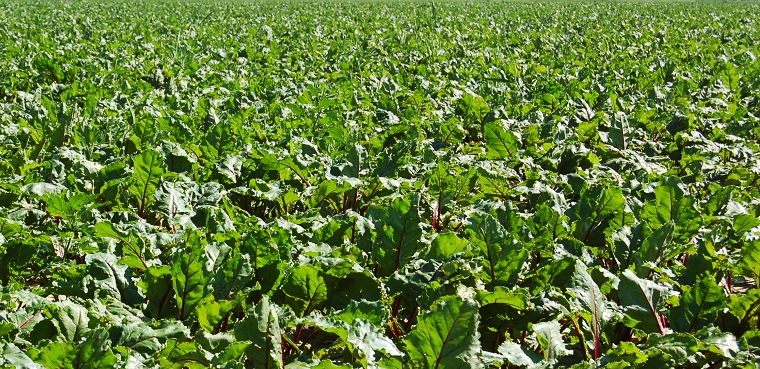
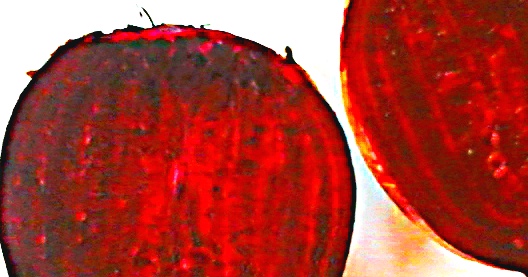
1030rapg Natural Red Color.
 Form: Powder
Form: Powder
Solubility: Water
Stability: Light: excellent
Heat: poor
pH: good
Applications:
Used as a natural food colorant to color food items like, beverage mix, hard
candy, chewing gum, salad dressing, fruit juice and concentrates, frostings, ice
cream, popsicles, frozen desserts, yogurts other foods.
1971ralg Natural Red Color
Form: Liquid
Solubility: Water
Stability: Light: excellent
Heat: poor
pH: good
Applications:
Used as a natural food colorant to color food items like hard candy, chewing gum, salad dressing,
fruit juice and concentrates, frostings, ice cream, popsicles, frozen desserts, yogurts other foods.
III. Carotenoid Red Colors
Canthaxanthin Red Color (CFR 73:75, 73:1075 and E161g)
Canthaxanthin is a member of caratenoids. It is widely distributed in nature. It has been found from mushrooms,
algae, sea weed and some fishes. That flamingos get red, orange and yellow colors on their feather is a result of
eating canthaxanthin-rich foods, including some species of fish.
As a member of carotenoids, canthaxanthin is a strong antioxidant. It was reported the strongest oil soluble
antioxidant found in nature. It plays the role of free radical-scavenger and prevent cell walls from damage by free
radicals. Canthaxanthin is approved for use as a food and feed coloring agent in different countries, including the
United States and the EU. Canthaxanthin can be used as a red color at a higher concentration and an orange color
at a lower concentration.
2460rapg Canthaxanthin Red Color
 Form: Granular
Form: Granular
Solubility: Water
Stability: Light: good
Heat: excellent
pH: excellent
Applications:
Used as a natural food colorant to color food items like different beverages,
including alcoholic and non-alcoholic, carbonated and non-carbonated, drink
mixes, bakery mixes, dairy (cheese, yogurt, butter, margarine), rice, baked
foods, cereals, extruded breakfast, frosting, icing, confectionery, chocolate
coating, chewing gums, gelatin, snacks, fruit juice and paste, ice cream,
popsicles, noodle/pasta, smoked fish/meats, pet foods and animal feeds.
IV. Lycopene (CFR 73:585, E160d)
Lycopene is a orange red pigment found in many fruits, vegetables and algae, including tomatoes, watermelons,
gacs, papayas, carrots, Lycopene is a member of carotenoids and have excellent antioxidant activity due to its
eleven conjugated double bonds in its molecular structure. Lycopene is an oil soluble substance but it is emulsified
to water soluble form for many food uses.
2472rapb Lycopene Color 5% Powder
 Form: Granular
Form: Granular
Solubility: Water
Stability: Light: good
Heat: excellent
pH: excellent
Applications:
Used as a natural food colorant to color food items like different beverages,
including alcoholic and non-alcoholic, carbonated and non-carbonated, drink
mixes, bakery mixes, dairy, rice, baked foods, cereals, extruded breakfast,
frosting, icing, confectionery, chocolate coating, chewing gums, gelatin, snacks,
fruit juice and paste, ice cream, popsicles, noodle/pasta, smoked fish/meats,
pet foods and animal feeds.
2473rapb Lycopene Color 10% powder
Form: Granular
Solubility: Water
Stability: Light: good
Heat: excellent
pH: excellent
Applications:
Used as a natural food colorant to color food items like processed meats and sea foods, beverages,
including alcoholic and non-alcoholic, carbonated and non-carbonated, drink mixes, bakery mixes,
dairy, rice, baked foods, cereals, extruded breakfast, frosting, icing, confectionery,
chocolate coating, chewing gums, gelatin, snacks, fruit juice and paste, ice cream, popsicles,
noodle/pasta, smoked fish/meats, pet foods and animal feeds.
1491rflg Lycopene Color 20% oil suspension
Form: Liquid
Solubility: Oil
Stability: Light: good
Heat: excellent
pH: excellent
Applications:
Used as a natural food colorant to color food items like dairy (cheese, butter, margarine), baked
foods, cereals, extruded breakfast, frosting, icing, chocolate coating, ice cream, noodle/pasta,
smoked fish/meats, pet foods and animal feeds.
1094oflg Lycopene Color Oil Solution
Form: Liquid
Solubility: oil
Stability: Light: good
Heat: excellent
pH: excellent
Applications:
Used as a natural food colorant to color food items like dairy (cheese, butter, margarine), baked
foods, cereals, extruded breakfast, frosting, icing, chocolate coating, ice cream, noodle/pasta,
smoked fish/meats, pet foods and animal feeds.
IV. Cochineal Extract and Carmine (21 CFR 73:100; 73:1100, 73:2087 and E120)
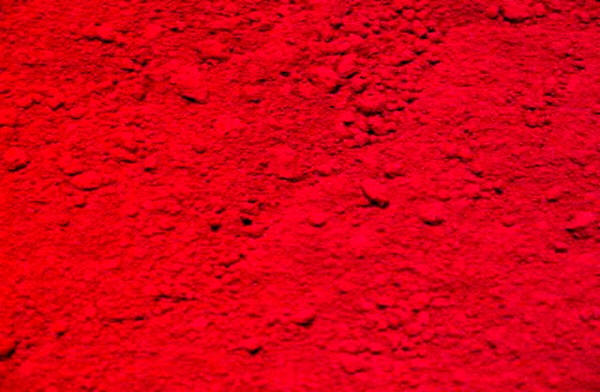 Cochineal extract is the concentrated
Cochineal extract is the concentrated
solution obtained after removing the
alcohol from an aqueous-alcoholic extract
of cochineal (Dactylopius coccus costa
(Coccus cacti L.)). The coloring principle
is chiefly carminic acid Carmine is the
aluminum or calcium-aluminum lake on
an aluminum hydroxide substrate of the
coloring principles, chiefly carminic acid, obtained by an aqueous extraction of cochineal (Dactylopius coccus
costa (Coccus cacti L.))
It is also called carmine lake, crimson lake, cochineal, natural red 4, C.I. 75470.
1020ralg Natural Red Color (Carmine solution)
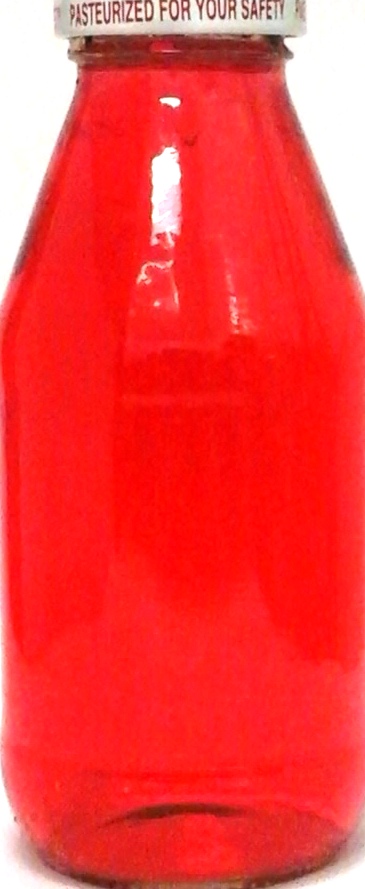 Form: Liquid
Form: Liquid
Solubility: Water
Stability: Light: excellent
Heat: excellent
pH: Used in pH 5 or above
Applications:
Being the most stable natural food color, it is used in high temperature processed
foods such as extruded breakfast, baked foods, candies and other foods like
chewing gum, salad dressing, fruit juice and concentrates, frostings, ice cream,
and frozen desserts, dessert, coatings and toppings, yogurts, custards, puddings,
gelatin and other foods.
1864rapg Natural Red Color (Carmine powder, water soluble)
Form: Powder
Solubility: Water
Stability: Light: excellent
Heat: excellent
pH: Used in pH 5 or above
Applications:
Being the most stable natural food color, it is used in high temperature processed foods such as
extruded breakfast, baked foods, candies and other foods like drink mix, chewing gum, salad
dressing, fruit juice and concentrates, frostings, ice cream, and frozen desserts, dessert, coatings
and toppings, yogurts, custards, puddings, gelatin and other foods.
1033ripg Natural Red Color (Carmine Powder, insoluble)
Form: Powder
Solubility: Insoluble in water. Soluble in alkaline media.
Stability: Light: excellent
Heat: excellent
pH: N/A
Applications:
Used as a natural food colorant to color food items like drink mix, bakery mix, chocolate coating,
tablet coating, lipsticks and other personal care products.
Back to top
1162arlb Natural Red Color (Cochineal extract, acid stable)
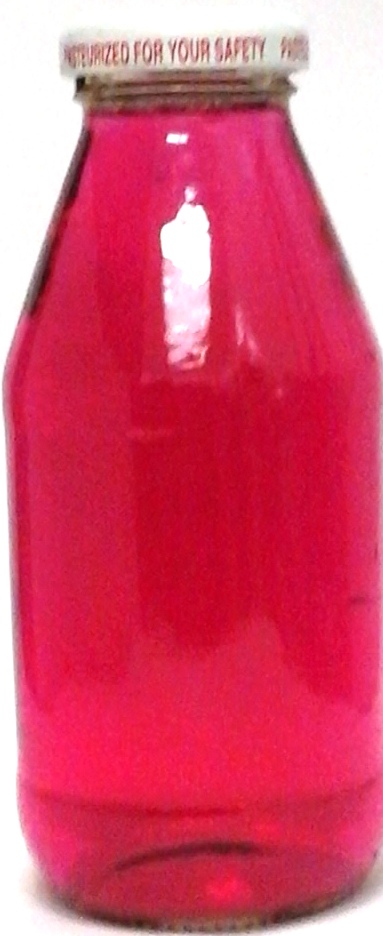 Form: Liquid
Form: Liquid
Solubility: Water
Stability: Light: excellent
Heat: excellent
pH: excellent
Applications:
Used as a natural food colorant to color food items like beverage, chewing gum,
salad dressing, fruit juice and concentrates, frostings, ice cream, and frozen
desserts, dessert, coatings and toppings, yogurts, custards, puddings, gelatin,
also used in high temperature processed foods such as extruded breakfast, baked
foods, candies and other foods.
Natural Yellow Colors
I. Beta Carotene Yellow/Orange Colors (21 CFR 73:95, E160a)
Beta Carotene is a very important member of carotenoids due to its function as a precursor of vitamin A. It is
abundant in nature such as carrots, pumpkin, and sweet potatoes. However, these vegetables are not widely used
to extract beta carotene due to economical reason. The commercially available beta-carotene from nature is
extracted from algae, Dunaliella Salina, for example, or from fermentation nowadays.
Being a non-polar compound, beta carotene is a lipophilic, and therefore a water insoluble substance. This
property limits its applications. Advanced emulsification technologies have successfully converted it to water
dispersible versions, enable it can be used in water based foods including beverages. However, some beta
carotene emulsions available in market form rings on beverage bottle necks after storage, due to separation of
oil-soluble beta carotene from beverage water. This may be caused by insufficient emulsification in processing or
poor stability of the emulsions. We have successfully created a beta carotene emulsion which can be used in
beverages without ringing/separation. This emulsion also has improved light and heat stability, giving extended
shelf life of the beverages.

1224-oalb, Natural Orange/Yellow Color. (natural beta carotene emulsion, ringing-free).
 Ringing free. Gives bright yellow to orange colors in beverage, depending on use levels. A good substitute for
Ringing free. Gives bright yellow to orange colors in beverage, depending on use levels. A good substitute for
Yellow No. 5.
Form: Liquid
Solubility: Water
Stability: Light: good
Heat: excellent
pH: excellent
Applications:
Used as a natural food colorant to color food items like different beverages,
including alcoholic and non-alcoholic, carbonated and non-carbonated, dairy
(cheese, yogurt, butter, margarine), rice, baked foods, cereals, extruded
breakfast, frosting, icing, confectionery, chocolate coating, chewing gums,
gelatin, snacks, fruit juice and paste, ice cream, popsicles, noodle/pasta,
smoked fish/meats, and many other foods.
1229oalb, Beta Carotene Color (beta carotene emulsion, ringing-free).
Ringing free. Gives bright yellow to orange colors in beverage, depending on use levels. A good substitute for
Yellow No. 5.
Form: Liquid
Solubility: Water
Stability: Light: good
Heat: excellent
pH: excellent
Applications:
Used as a natural food colorant to color food items like different beverages,
including alcoholic and non-alcoholic, carbonated and non-carbonated, dairy
(cheese, yogurt, butter, margarine), rice, baked foods, cereals, extruded
breakfast, frosting, icing, confectionery, chocolate coating, chewing gums,
gelatin, snacks, fruit juice and paste, ice cream, popsicles, noodle/pasta, smoked
fish/meats, and many other foods.
2415oapb Natural Beta Carotene Color Powder (1% beta carotene)
Form: Powder
Solubility: Water
Stability: Light: good
Heat: excellent
pH: excellent
Applications:
Used as a natural food colorant to color food items like drink mixes, beverages, including alcoholic
and non-alcoholic, carbonated and non-carbonated, bakery mixes, dairy (cheese, yogurt, butter,
margarine), rice, baked foods, cereals, extruded breakfast, frosting, icing, confectionery,
chocolate coating, chewing gums, gelatin, snacks, fruit juice and paste, ice cream, popsicles,
noodle/pasta, smoked fish/meats, and many other foods.
1858oapb Beta Carotene Color (1% beta carotene)
Form: Powder
Solubility: Water
Stability: Light: good
Heat: excellent
pH: excellent
Applications:
Used as a natural food colorant to color food items like drink mixes, beverages, including alcoholic
and non-alcoholic, carbonated and non-carbonated, drink mixes, bakery mixes, dairy (cheese,
yogurt, butter, margarine), rice, baked foods, cereals, extruded breakfast, frosting, icing,
confectionery, chocolate coating, chewing gums, gelatin, snacks, fruit juice and paste, ice cream,
popsicles, noodle/pasta, smoked fish/meats, and many other foods.
II. Curcumin (Turmeric) Color (21 CFR 73:615, E100).
The roots of Curcuma longa, commonly known as turmeric, a member of ginger family, contain abundant yellow
substance–curcumin. With conjugated multiple unsaturated double bonds in its molecular structure, curcumin is
known to have strong anti-oxidative activity, three times as strong as vitamin E. Curcumin has a bright yellow
color and has been used a natural alternative to FD&C Yellow No.5 in many food applications.
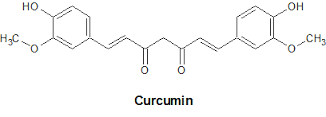
1034yalg Natural Yellow Color
T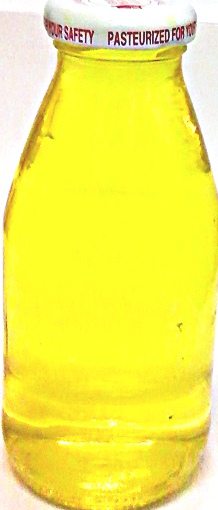 his is a conventional preparation of curcumin emulsion with polysorbate 80 (an emulsifier).
his is a conventional preparation of curcumin emulsion with polysorbate 80 (an emulsifier).
Form: Liquid
Solubility: Water
Stability: Light: poor
Heat: good
pH: suitable in acidic pH
Applications:
Used as a natural food colorant to color food items like pickles, dairy (cheese,
yogurt, butter, margarine), rice, bakery, cearals, frosting, icing, confectionery,
chocolate coating, chewing gums, gelatin, snacks, fruit juice and paste, ice
cream, popsicles, noodle/pasta and many other foods.
2215yalb Natural Yellow Color (organic compliant)
This curcumin emulsion is exclusively made with our special technology with all natural
ingredients, without polysorbates. It is organic compliant. Furthermore, its light stability
is greatly improved!
Form: Liquid
Solubility: Water
Stability: Light: good
Heat: good
pH: suitable in acidic pH
Applications:
Used as a natural food colorant to color food items like beverages, including alcoholic and
non-alcoholic, carbonated and non-carbonated, dairy (cheese, yogurt, butter, margarine), rice,
baked foods, cereals, extruded breakfast, frosting, icing, confectionery, chocolate coating, chewing
gums, gelatin, snacks, fruit juice and paste, ice cream, popsicles, noodle/pasta,
smoked fish/meats and many other foods.
1099yapg Natural Yellow Color
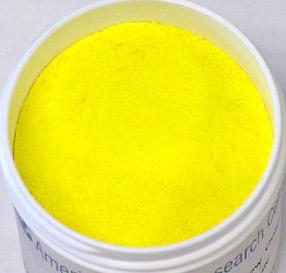 Form: Powder
Form: Powder
Solubility: Water
Stability: Light: Poor
Heat: good
pH: good
Applications:
Used as a natural food colorant to color food items like beverage mix, bakery mix, dairy (cheese,
butter, margarine), baked foods, cereals, extruded breakfast, frosting, icing, chocolate coating, ice
cream, noodle/pasta, smoked fish/meats, pet foods and animal feeds.
Back to top
III. Lutein (Aztec Marigold Flower Extract) Yellow Color (21 CFR 73:295, E161b)
Lutein, a xanthophyll, belongs to carotenoid family. It is abundant in green leafy vegetables. Aztec marigold
petals are good source for extraction of lutein. Lutein plays an important anti-oxidation role in protecting
eye from photo-damage. It gives the yellow color in chicken skin and egg yolk. Lutein is an oil soluble substance.
However, it can be emulsified to a water dispersible version and can be widely used in water based foods and feeds.

1230yalb Natural Yellow Color (Marigold petal extract)
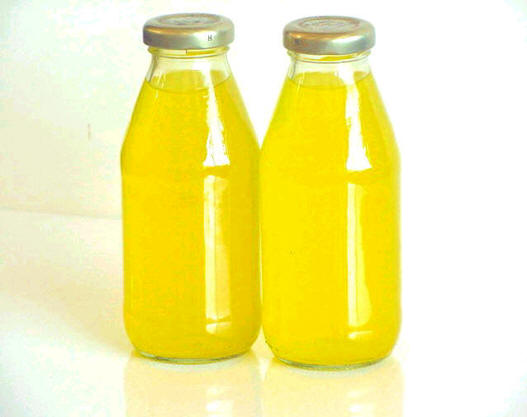
Form: Liquid
Solubility: Water
Stability: Light: good
Heat: good
pH: suitable in acidic pH
Applications:
Used as a natural food colorant
to color food items like
different beverages, including
alcoholic and non-alcoholic,
carbonated and non-
carbonated, dairy (cheese, yogurt, butter, margarine), rice, baked foods, cereals, extruded breakfast,
frosting, icing, confectionery,
chocolate coating, chewing gums, gelatin, snacks, fruit juice and paste, ice cream, popsicles, noodle/pasta,
and chicken feeds. Check local regulatory for restrictions before use.
1503yflg Natural Yellow Color (Marigold Petal extract)
Form: Liquid
Solubility: Oil
Stability: Light: good
Heat: good
pH: N/A
Applications:
Used as a natural food colorant to color food items like chicken feed, dairy (cheese, yogurt, butter,
margarine), rice, baked foods, cereals, extruded breakfast, frosting, icing, confectionery,
chocolate coating, snacks, ice cream, noodle and pasta. Check local regulatory for restrictions before use.
For more product list, or if you have any questions,
please call 1-951-735-2711 for details.

